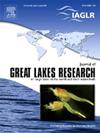Long-term trends in particulate nutrients in offshore waters of the Laurentian Great Lakes
IF 2.5
3区 环境科学与生态学
Q3 ENVIRONMENTAL SCIENCES
引用次数: 0
Abstract
The Laurentian Great Lakes have undergone significant ecological changes in recent decades. We characterized patterns and long-term trends in particulate nutrient concentrations and seston stoichiometry from 1997 to 2019 across all five Great Lakes using spring and summer particulate nutrient data routinely collected by the US EPA GLNPO Water Quality Monitoring Program. We observed broad differences between the upper and lower Great Lakes, likely driven by varying surrounding land use, nutrient dynamics, light and hydrological regimes, and internal processes. Lakes Huron and Michigan exhibited the most significant changes in particulate nutrient concentrations throughout the study period. Despite changes in particulate nutrient concentrations, no significant trends in seston stoichiometric ratios were observed in any of the lakes. We identified two periods of abrupt change (mid-2000s and 2012) in the particulate nutrient time series. The first period of change was characterized by significant declines in total suspended solids, particulate phosphorus, and particulate organic carbon concentrations, concurrent with the timing of documented lower food web changes in Lakes Huron and Michigan but preceding the period of rapid quagga mussel expansion into the Great Lakes. Since 2012, particulate nitrogen has abruptly increased in all lakes, resulting in increasingly imbalanced seston N:P and C:N. These shifts may have broader ecological implications, potentially affecting organisms higher up the food web through altered nutrient availability and balance. Tracking particulate nutrients will continue to be critical for lake management.
劳伦森五大湖近海水域微粒营养物的长期趋势
近几十年来,劳伦森五大湖经历了重大的生态变化。我们利用美国环保署GLNPO水质监测项目常规收集的春季和夏季颗粒养分数据,对1997年至2019年五大湖颗粒养分浓度和森林化学计量学的模式和长期趋势进行了表征。我们观察到五大湖上下之间存在巨大差异,这可能是由不同的周围土地利用、营养动态、光照和水文制度以及内部过程造成的。在整个研究期间,休伦湖和密歇根湖的颗粒营养物质浓度变化最为显著。尽管颗粒营养物浓度发生了变化,但在任何湖泊中都没有观察到明显的森林化学计量比变化趋势。我们确定了颗粒物营养物质时间序列的两个突变时期(2000年代中期和2012年)。第一个变化时期的特征是总悬浮固体、颗粒磷和颗粒有机碳浓度的显著下降,与休伦湖和密歇根湖记录的较低食物网变化时间同时发生,但在白斑贻贝迅速扩张到五大湖之前。2012年以来,各湖泊颗粒态氮急剧增加,导致季氮:磷和碳:氮失衡加剧。这些变化可能会产生更广泛的生态影响,通过改变营养物质的可用性和平衡,可能会影响食物网上层的生物。追踪颗粒营养物将继续对湖泊管理至关重要。
本文章由计算机程序翻译,如有差异,请以英文原文为准。
求助全文
约1分钟内获得全文
求助全文
来源期刊

Journal of Great Lakes Research
生物-海洋与淡水生物学
CiteScore
5.10
自引率
13.60%
发文量
178
审稿时长
6 months
期刊介绍:
Published six times per year, the Journal of Great Lakes Research is multidisciplinary in its coverage, publishing manuscripts on a wide range of theoretical and applied topics in the natural science fields of biology, chemistry, physics, geology, as well as social sciences of the large lakes of the world and their watersheds. Large lakes generally are considered as those lakes which have a mean surface area of >500 km2 (see Herdendorf, C.E. 1982. Large lakes of the world. J. Great Lakes Res. 8:379-412, for examples), although smaller lakes may be considered, especially if they are very deep. We also welcome contributions on saline lakes and research on estuarine waters where the results have application to large lakes.
 求助内容:
求助内容: 应助结果提醒方式:
应助结果提醒方式:


